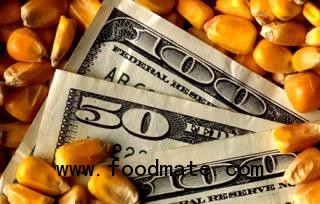
Rising prices for corn, soybeans and other agricultural commodities are increasing the financing needs of food-related businesses, including meat producers, grain merchants and makers of breakfast cereals, according to bankers.
The drought that plagued large swaths of the U.S. heartland this summer resulted in another sharp increase in the price of corn and other commodities. Further, "there is already talk of a drought next year," which could make it difficult to rebuild corn supply and push prices down, says Elizabeth Hund, an agricultural banker at U.S. Bancorp (USB) in Minneapolis.
"It's one thing if I have to buy $8 corn [per bushel] for a few months" as a grain merchant or meat producer, says Ms. Hund, who runs lending to millers, grain merchants and food companies with $500 million or more in revenue. "But if I have to pay $8 for corn for the foreseeable future, that changes the business model."
For decades, corn prices had remained fairly steady at around $3 per bushel. Prices started rising in 2007, and became more volatile, due to rising demand for corn. On Thursday, corn futures were trading at $7.74 a bushel according to data provided by FactSet, up about 20% this year.
The result: "Bigger lines [of credit] and terms as long as [borrowers] can get. We are seeing that across the board" among the meat industry and food manufacturers, she says.
"Most of your increase in loan demand is coming from the protein and dairy sector," says Roger Sturdevant, the head of agricultural banking at Bank of the West in San Francisco.
For dairy producers, the cost of feed makes up about half their overall expenses and "that increase in input costs needs to be financed, typically borrowed," he says. Milk prices have been lagging the increase in commodity prices, he says.
Ultimately, higher commodity prices help farmers, who overall are in good financial shape, according to bankers at U.S. Bancorp and Bank of the West.
However, rising prices for fuel, fossil-fuel-based fertilizer and the cost of seeds "are higher almost across the board as well," says John Elmer, U.S. Bancorp's head of community banking, the unit that makes most farm loans.
Those increasing input costs, in addition to rising prices for farmland, resulted in more loan demand from farmers. In addition, more land is planted with corn and beans, which also required more loans as upfront financing, bankers say.
Loans to farmers and dairy and meat producers are broken out in regulatory filings as loans to finance agricultural production and are separate from loans secured by farmland.
Overall agriculture loans at banks, thrifts, and credit unions rose 11% in the second quarter from a year earlier, according to SNL Financial. Bankers expect demand for agricultural loans to continue to increase.
Agricultural loans are a small part of U.S. Bancorp's $216 billion loans book, but they rose almost 13% in the second quarter from a year earlier, to $980 million, while overall loans rose 8%. In the first two months of the third quarter, agricultural loan commitments were up another 10%, Ms. Hund says.
At all of Rabobank's U.S. operations combined, agricultural loans rose 50% in the second quarter from a year earlier, to $3.2 billion. "Agriculture has been a brighter spot in the economy and the outlook is promising," says Sean Dowdall, the executive director of marketing of Rabobank, a Roseville, Calif., subsidiary of Dutch bank Rabobank Group.
According to SNL, Rabobank is the second-largest agricultural lender in the U.S. Wells Fargo & Co. (WFC) is the largest, and at the San Francisco bank such loans rose 7.8% in the second quarter to $5.8 billion. Wells Fargo's total loans were $775.2 billion, up 3.1% from a year earlier.
"Wells Fargo is fundamentally bullish on agriculture," Perry Pelos, head of Wells Fargo commercial banking, said in an email. Volatility in most agricultural commodities over the past few years may also require other tools from banks to help farmers, such as hedging feed costs and milk prices, he said.
At Bank West's parent, BancWest Corp., agricultural loans rose 24%, to $2.2 billion, in the second quarter from a year earlier. BancWest is the U.S. banking subsidiary of BNP Paribas SA (BNP.FR, BNPQY), and the nation's third-largest agricultural lender, according to SNL.
Bankers like the loans because agricultural borrowers are heavy users of credit, boast high incomes to fund repayment, and because the collateral is attractive. Interest rates on agricultural loans are about 2% to 3% over the 30-day Libor rate, which is currently at around 0.2%.
Increasing meat consumption in the U.S. and abroad has pushed up corn and soybean prices, a major ingredient of animal feed. In addition, U.S. corn is now being exported, made into syrup and used to make packaging material and ethanol, which means demand for corn has increased.
For grain merchants, the impact of higher corn prices is neutral in the long run, because rising prices will decrease sale volume but increase profit margins. That industry will need short-term loans to cover the increased input costs, bankers said.
For meat producers who have to feed poultry and cattle, things are different; The poultry industry can adjust the size of their flocks fairly quickly because life spans are short. But once pork and beef herds are cut, producers have a harder time rebuilding them when rising feed prices can be passed along to the consumer or corn prices come down, bankers said.
As long as grain prices stay elevated, loan demand will rise, if only because higher corn and soy bean prices will entice farmers to farm more land, bankers said.
The fourth quarter is a slow one for loans to farmers--they establish their new lines of credit traditionally in the first and second quarters, when farmers plant. Higher seed prices may entice farmers to switch crops--but also to farm more land. "If commodity prices stay where they are or increase, acreage will increase," says Barry Martin, a U.S. Bancorp banker. That, again, requires more loans.





